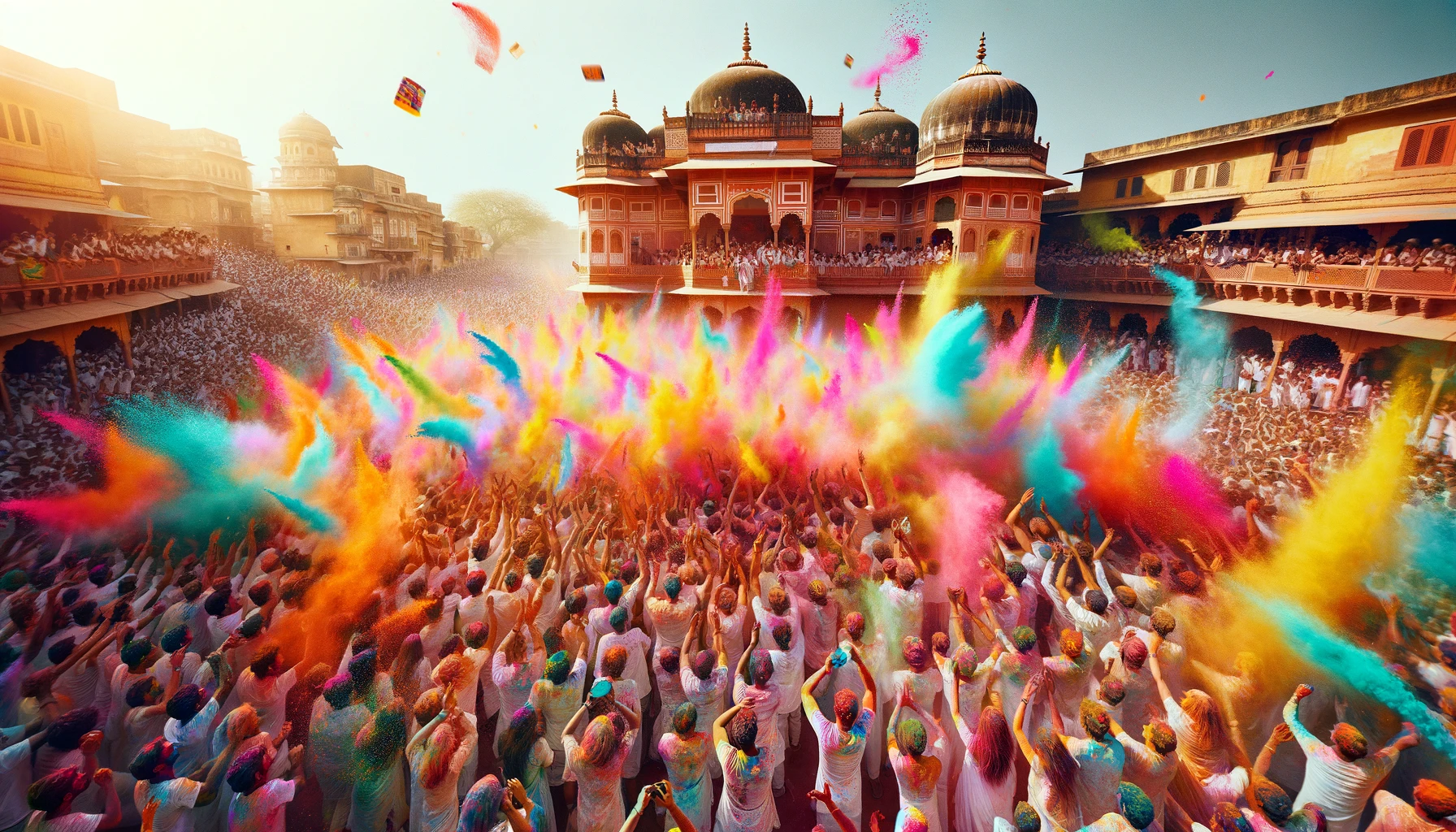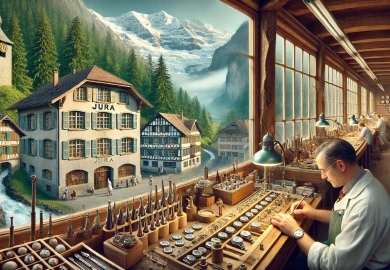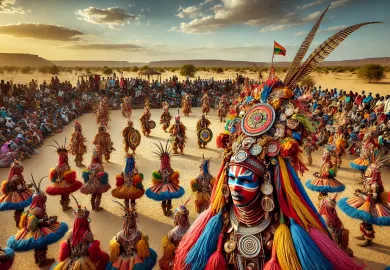
Holi, known as the “Festival of Colors,” is one of the most joyous and exuberant celebrations in India. Marking the arrival of spring, this vibrant festival transcends religious and cultural boundaries, bringing people together in a riot of colors, music, and dance. Celebrated primarily in India, Holi has gained popularity worldwide, with its significance rooted in ancient traditions and mythology. This article delves into the origins, rituals, and cultural impact of Holi, providing a comprehensive guide to understanding and experiencing this remarkable festival.
The Origins of Holi: A Mythological Journey
Holi’s origins can be traced back to ancient Hindu mythology, where it is deeply intertwined with various legends and folklore. One of the most popular stories is that of Prahlad and Holika, which symbolizes the victory of good over evil. According to the legend, Prahlad, a devout follower of Lord Vishnu, was persecuted by his father, the demon king Hiranyakashipu. The king’s sister, Holika, possessed a boon that made her immune to fire. To kill Prahlad, Holika tricked him into sitting on her lap in a bonfire. However, due to his unwavering devotion, Prahlad emerged unscathed while Holika perished in the flames. This event is commemorated on the eve of Holi with a ritualistic bonfire known as “Holika Dahan.”
Another legend associated with Holi is the love story of Lord Krishna and Radha. Krishna, who had a dark complexion, was envious of Radha’s fair skin. On his mother’s advice, he playfully smeared colors on Radha’s face, leading to the tradition of throwing colors during Holi. This playful act of coloring each other is now the most iconic aspect of the festival, symbolizing love, joy, and the breaking down of social barriers.
Holi is also connected to the arrival of spring, a season of rejuvenation and new beginnings. In ancient times, people celebrated the end of winter and the blossoming of nature with rituals that eventually evolved into the modern-day Holi. The festival is a reminder of the cyclical nature of life, where the harshness of winter gives way to the warmth and vitality of spring.
How Holi is Celebrated: Traditions and Rituals
Holi is celebrated with a series of rituals that vary across different regions of India. The festival typically begins with “Holika Dahan” on the night before Holi, where bonfires are lit to symbolize the triumph of good over evil. People gather around the fire, offering prayers and seeking blessings for prosperity and protection. The ashes from the bonfire are considered sacred and are often applied to the forehead as a mark of purification.
The main day of Holi, also known as “Rangwali Holi” or “Dhuleti,” is when the streets come alive with color. People of all ages, dressed in white, gather to play with dry powdered colors known as “gulal” and colored water. The air is filled with laughter, music, and the scent of flowers as participants chase each other with water guns, balloons, and buckets of colored water. It’s a time of unbridled joy where social norms are temporarily suspended, and everyone is equal, regardless of caste, creed, or social status.
In addition to the vibrant color play, Holi is also marked by singing and dancing. Traditional folk songs and dance forms like “Garba” and “Dandiya” are performed, accompanied by the beats of drums and other musical instruments. In some regions, people celebrate by singing “Phagwa,” a type of Holi folk song that narrates the stories of Radha and Krishna. The atmosphere is electric, with communities coming together in a spirit of unity and celebration.
Regional Variations of Holi: A Diverse Celebration
While the essence of Holi remains the same across India, the way it is celebrated varies significantly from one region to another. Each region adds its unique flavor to the festival, showcasing the diversity of Indian culture.
In North India, especially in the states of Uttar Pradesh and Bihar, Holi is celebrated with great enthusiasm. The town of Mathura, believed to be the birthplace of Lord Krishna, hosts some of the most spectacular Holi celebrations. The “Lathmar Holi” of Barsana, where women playfully beat men with sticks, is a famous tradition that attracts visitors from all over the world. In Varanasi, Holi takes on a more spiritual tone, with rituals and prayers performed along the ghats of the sacred Ganges River.
In West Bengal, Holi is known as “Dol Jatra” or “Dol Purnima.” It is celebrated in honor of Lord Krishna and Radha, with devotees placing idols of the deities on decorated swings. The festival here is characterized by a more subdued and artistic celebration, with songs, dances, and the application of “abir” (colored powder) on each other’s faces.
In the state of Maharashtra, Holi is celebrated with a blend of colors and traditional delicacies. The festival is known for the preparation of “Puran Poli,” a sweet flatbread stuffed with a mixture of jaggery and lentils. In Mumbai, the “Holi parties” are a major attraction, where people gather in large groups to celebrate with music, dance, and colors.
The tribal communities of Odisha and Jharkhand celebrate Holi as “Phaguwa,” with unique customs and rituals that reflect their rich cultural heritage. The festival here is marked by traditional dances, songs, and the consumption of local delicacies.
The Global Impact of Holi: Spreading Joy Across Borders
Holi is no longer confined to the borders of India; it has become a global phenomenon. The festival’s universal themes of love, joy, and the triumph of good over evil resonate with people worldwide, making it a popular celebration in many countries.
In recent years, Holi festivals have been organized in cities across Europe, North America, and Australia, attracting people from diverse backgrounds. These events, often referred to as “Color Runs” or “Holi Festivals,” recreate the vibrant atmosphere of the Indian celebration with music, dance, and the iconic color play. While these international versions of Holi may differ in scale and setting, the essence of the festival remains intact, spreading the message of unity and happiness.
The popularity of Holi in the global arena has also led to its depiction in various forms of media, including movies, music videos, and advertisements. This has further fueled its appeal, introducing the festival to new audiences and making it a symbol of cultural diversity and inclusivity.
Holi’s global impact is also seen in the way it has been embraced by different communities. In countries like Nepal and Bangladesh, where Hinduism is practiced, Holi is celebrated with the same fervor as in India. Even in non-Hindu-majority countries, the festival is observed by Indian diaspora communities, bringing a piece of their homeland’s culture to their adopted countries.
Holi’s Cultural Significance: More Than Just Colors
Beyond the colors and celebrations, Holi holds profound cultural significance. The festival serves as a reminder of the importance of forgiveness, renewal, and the breaking down of social barriers. In a society where divisions based on caste, religion, and social status have historically been prevalent, Holi provides a space where these differences are momentarily set aside. The act of playing with colors symbolizes the shedding of old grievances and the beginning of new friendships.
Holi also carries environmental and ecological messages. Traditionally, the colors used during Holi were derived from natural sources like flowers, herbs, and spices. These natural colors not only added to the festival’s beauty but also promoted the use of eco-friendly practices. In recent years, there has been a resurgence of interest in using organic and natural colors, driven by a growing awareness of the harmful effects of synthetic dyes on the skin and environment.
The festival’s timing, at the cusp of spring, aligns with the agricultural cycle in India. Holi marks the end of the Rabi crop season, a time of harvest and abundance. For farmers, it is a time to celebrate the fruits of their labor and to seek blessings for the upcoming Kharif season. This connection to the land and nature underscores the festival’s deep-rooted ties to India’s agrarian culture.
Moreover, Holi’s emphasis on community and togetherness resonates with the broader Indian ethos of “Vasudhaiva Kutumbakam” (the world is one family). It is a celebration that transcends individual differences and fosters a sense of belonging and unity. In a world often divided by conflicts and prejudices, Holi stands as a symbol of peace, harmony, and the universal joy of human connection.








